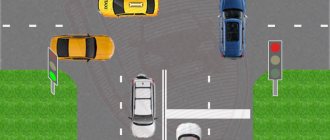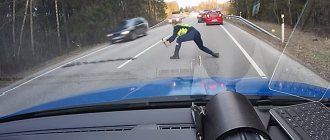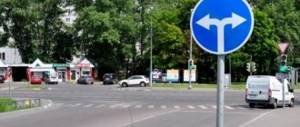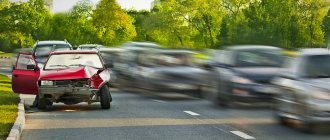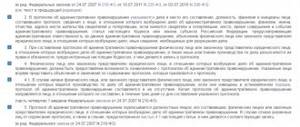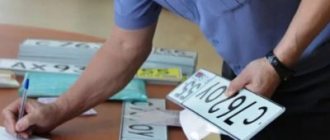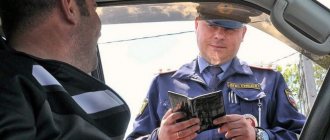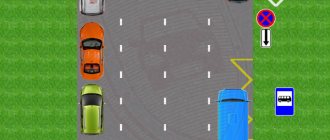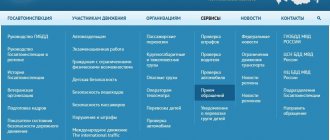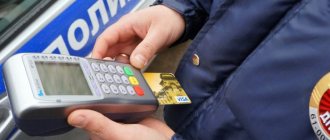The traffic rules (hereinafter referred to as traffic rules) clearly describe where the zone of operation of the “No Stopping” sign begins and ends, in which case the motorist can be fined and even have the car towed. You can learn more about this in Appendix No. 1 to the Traffic Regulations (hereinafter referred to as the Appendix). In addition, information about signs regulating the movement of vehicles, and, in particular, about “Stopping and parking prohibited” signs, is also available in GOST R 52289-2004 (hereinafter referred to as GOST).
In order to avoid getting into an unpleasant situation, you should understand how the sign number 3.27 “Stopping is prohibited” works in 2021, as well as what to do if there is an additional sign next to it or a temporary restriction.
What is the difference between two similar signs?
Ordinary people often do not make a difference between these two designations, although there is one. Prohibitory sign 3.27 is made in the form of a blue circle, bordered by a red frame, crossed out by two crosswise stripes. This means that stopping in the area covered by this sign is prohibited.
Sign 3.28 “Parking prohibited” is similar to the previous one: a blue circle with one line crossed diagonally. It prohibits parking for extended periods of time.
According to traffic regulations, parking is leaving a car parked for a period of time exceeding 5 minutes. Is it possible for a driver to drop off a passenger near a “No Stopping” sign? No. But if the driver needs to drop off a passenger, he can do this within the coverage area of the blue circle number 3.28, and this will not be a violation. The car can also stop to seat a passenger, unload or load cargo.
Where is the “No Parking” sign installed?
The ban on long-term parking applies to the following sections of the road:
- where a parked car may interfere with the passage of other cars;
- in places where a car parked on the side of the road reduces traffic safety in this area;
- in areas where a parked car can provoke traffic violations by other road users.
What is the difference between a parking lot and a stop?
Most drivers encounter unexpected difficulties when they come across two seemingly similar signs on their way. In the traffic rules they are listed under numbers 3.27 “Stopping is prohibited” (OZ) and 3.28 “Parking is prohibited” (NW).
The indicators are presented in the form of two round panels with a red border and a blue background.
Sign 3.27 shows two crossed stripes, sign 3.28 shows one diagonal stripe.
Having seen the “NW” sign, the driver must understand that parking in this place is prohibited, but the rule does not apply to a short stop. However, the exception is cases when it is impossible to drive a vehicle (for example, due to health problems or car breakdown).
In the set of traffic rules, this sign appeared to ensure unimpeded boarding and disembarking of passengers, as well as for loading and unloading the vehicle itself.
Therefore, if the above reasons forced the driver to stay a little longer than expected, then traffic police officers are unlikely to file a claim against him.
You can stand under the “No Parking” law for more than 5 minutes
As for the “OZ” sign, everything is very clear here, since parking or a short stop is strictly prohibited. There is no point in throwing angry exclamations towards the forbidden symbol, because it was installed for a reason.
Most likely, a parked car can provoke an accident, as well as motivate other road users to commit a similar violation.
How to determine the prohibition area?
The area where the “circle” 3.27 operates is determined by the Appendix and GOST. The area along the road in which the prohibition is in force is limited by the intersection closest to the place where the prohibition symbol is installed in the direction of travel, or by the border of the populated area (both at the entrance and exit). The “No Stopping” sign can also be terminated by a sign placed next to it, indicating the direction of its action and the length of the road along which stopping and parking is prohibited. If there is a cancellation sign further in the direction of travel, you should assume that the coverage area of the sign has ended.
How does the ban work in combination with signs?
Depending on which sign under the “Stopping is prohibited” sign, which sign follows it further in the direction of travel, its area of action may change:
- if after 3.27 there is the same blue circle, but with a sign numbered 8.2.3 (down arrow), then the ban is relevant until this sign;
- if the “No Parking” sign is installed together with sign number 8.2.2 (arrow up), and the distance is marked next to the arrow on the sign, then the zone where it is necessary to comply with the regulation will be extended to this distance. You can measure it by eye or using a navigator, but, as a rule, after the specified number of meters, the same road sign appears with a sign numbered 8.2.3 (see information above);
- if the graphic designation “stopping and parking prohibited” is adjacent to plate 8.2.4, on which the arrow points both up and down, then its effect extends to the road, both after the installation site and before it. Often such a ban is placed where it is impossible to stop along a long stretch of the route. This reminds the driver that the ban is still in effect.
The ban can also be supplemented with a sign depicting one of the categories of vehicles. For example, if there is a truck next to the blue circle, this means that trucks are prohibited from parking.
Restriction area and additional signs
According to traffic rules, parking is prohibited immediately behind a warning sign. That is, the driver in front of him can easily stop the car and go about his business. Behind the limiter, this will already be counted as a traffic violation.
Let's figure out how long the limiter applies.
- If the sign is located within the city, then the nearest intersection terminates its validity. In this case, intersecting roads of different levels are not considered an intersection.
- If the sign is installed on a country road, then the beginning of the populated area means the end of the restriction.
- The same applies to the sign at the end of a populated area; if there was a restriction in place before, then having left the city, village or village, the driver can safely stop the car for a long period of time.
- Sign 3.31 also terminates all possible restrictions, including parking.
- In addition, the “Parking is prohibited” sign may be adjacent to the supplementary plate 8.2.2, which establishes the distance during which the limiter is in effect.
You should also take into account the information on joint signs. For example, an arrow in both directions together with a round sign means that the driver is still within the latter's range. If the car owner sees a “No Parking” sign supplemented by a downward arrow, it means that after it you can stop, this is the end of the coverage area.
Also, together with the main plate, you can see supplementary 8.4.1 - 8.4.8, they indicate the type of transport that is subject to the restrictive sign. If your car is not one of them, you can safely leave it in the area of the sign.
Limiting the period of the ban by time
Signs 3.27 and 3.28 may not be valid all the time, but only on certain days or hours. For example, a blue no-parking circle with a white Roman numeral "1" through a line means that parking is prohibited only on odd days of the month (3.29). And two crossed out sticks on a blue background (3.30), on the contrary, indicate that parking is prohibited on even days.
Parking or stopping may also be prohibited during the day or night. As a rule, the restriction applies during the day, but at night you can ignore the sign. This is evidenced by a sign underneath it, indicating the time interval during which the ban is valid. So, if under the circle on the sign it says “8:00-20:00”, this means that you cannot leave your car here from eight in the morning to eight in the evening.
What does the “No Stopping” and “No Parking” sign mean?
The traffic rules of the Russian Federation assigned the numbers 3.28 to these signs (parking is prohibited), as well as 3.29 and 3.30 (for varieties of this sign that prohibit parking on odd and even days), and 3.27 (stopping is prohibited). It is better to consider them in this order:
- A sign prohibiting parking means that you cannot park (stop) for more than 5 minutes in its coverage area.
- The prohibition on stopping means that you cannot stop even for a moment in the area of the sign (there are exceptions - more on them at the end of the article).
Obviously, road sign 3.27 “No Stopping” dictates more stringent rules, but our proceedings are devoted to the areas of coverage of these signs, and in this regard the situation is very similar.
If there are no other signs and signs
If there is no sign or road marking next to the sign, then the order applies to the first intersection with another street and road. Of course, exits into courtyards and paths do not count. In order not to doubt whether the intersection sign has been canceled or you still cannot stop, you should refer to the traffic rules, where this point is clearly stated.
The text of the Appendix states that the effect of the no-stop sign cannot be canceled:
- departures from adjacent territories;
- intersections with roads leading to fields or forests;
- any intersections with secondary roads that do not have a main road sign in front of them.
The ban is canceled when the motorist leaves the city or other populated area where the ban has been established, or enters the populated area after passing the prohibitory sign. If there is both an intersection and a populated area on the way, then the ban is canceled by whichever the driver reaches first.
How to understand that a settlement has begun or ended
The fact that the village or city is already behind is indicated not by the driver’s impression, but by road signs. Even if the last houses have already disappeared over the horizon, this does not mean that you can leave your car here. Likewise, a driver should not be confused by shopping centers and pedestrians if he has passed a sign informing him that he has left a populated area.
The beginning of a settlement is indicated by a road sign with its name on a white rectangle. Next to the name there may be silhouettes of houses. Departure from a populated area is indicated in the same way, only its name will be crossed out.
Important: you should carefully follow the signs on the road. Often, immediately after leaving a village or city, there is another “No Parking” road sign and, despite the cancellation of the previous one, you still won’t be able to park.
What if the prohibition area extends beyond the intersection?
What to do if there is an intersection ahead, but there are no signs or other signs next to the “No Stopping” sign, it’s clear. It is also clear what to do if the pointer is available. But what to do in a situation where there is an intersection ahead with a “main road” sign, but the arrow next to the prohibition of stopping makes it clear that its coverage area extends beyond the intersection.
The traffic rules do not provide any clear instructions regarding this situation. The answer to the question can be found in the text of GOST, paragraph 5.9. The prohibition area indicated on the sign should not be greater than that established for these signs in clause 5.4.31. This paragraph contains the same information as in the text above:
The sign's coverage area ends after the first intersection, entry or exit from a populated area.
Accordingly, if there is a sign in front of the driver and an intersection or exit from a populated area that causes conflicting interpretations of the prohibition, you need to focus on GOST 5.4.31 and follow the instructions of the sign before the intersection, exit or entry into the populated area.
Amount of fine for violating the ban on stopping and parking
If the driver decides to stop where the ban is in force, he can be fined 1,500 rubles if the violation occurred in one of the regions of Russia, or 3,000 rubles if the situation occurred in Moscow or St. Petersburg. The amount of the fine is established by Part 4 and Part 5 of Article 12.16 of the Code of Administrative Offenses of the Russian Federation.
In what cases can a fine be avoided?
You can avoid punishment for unauthorized parking if it was forced. For example, the driver stopped due to a technical malfunction of the vehicle, or as a result of an accident. Being at the side of the road due to a sharp deterioration in the driver’s well-being is not subject to a fine.
But, even if there is a good reason for an unauthorized stop, you should repark the car as soon as possible, and also turn on the emergency signal.
Can a security camera record a violation?
A video recording camera, among other things, can film an illegally parked car and then send a “chain letter” to its owner. It is worth noting that this violation is often recorded on site not by stationary cameras, but by moving traffic police vehicles equipped with video equipment. Photo recording cannot serve as evidence of a violation, since it is impossible to determine from a photograph whether the car is moving or standing still.
Is it possible to reduce the amount of the fine?
If the fact of leaving a vehicle in the wrong place was recorded, then punishment cannot be avoided. However, as with other traffic violations, you can save half of the fine due if you pay it within 20 days after the order was issued.
Can a car left in a prohibited area be towed?
If a car is parked in violation of the rules, the car may be towed to a parking lot. This should be indicated by a sign with a picture of a tow truck, or the inscription “A tow truck is working.” In this case, you will have to pay a fine, find your car and pay for parking. Therefore, you should carefully follow the stopping rules described in the 2021 Traffic Regulations and do not leave your vehicle in the wrong place.
Common Questions
Even after familiarizing yourself with the theoretical course, many drivers still have questions. Meanwhile, their detailed explanation will also help to avoid various unpleasant situations on the roads.
In what places should you not stop, despite the absence of a sign?
Do not forget that stopping and parking may be prohibited outside the coverage area of the signs in question.
All these areas are spelled out in detail in the traffic rules, and are also subject to fines, the amount of which is determined by Article 12.19 of Chapter 12 of the Administrative Code.
This table of administrative fines will help you understand the issue of penalties for illegal parking in more detail.
Can a car left in a prohibited area be towed?
Cars left by their owners in the wrong place are subject to forced evacuation, provided that they impede traffic on the site or threaten its safety.
Under this sign, the driver of the vehicle will be charged not only a fine for parking in a prohibited area, but also payment for tow truck services and a parking fine.
